
1. Cognitive approach is focused on how our mental processes affect our behavior
1.1. The Study of Internal Mental Processes Internal mental processes are the operations that occur during thinking.Examples include how we turn the information from our eyes into a usable form (perception); how we choose what to think about (attention); how we store information to use in the future (memory); how we construct meaningful sentences to communicate with others (language); and how we construct new solutions (problem- solving).
1.2. Schema theory is an information-processing model that emphasises how perception and memory are shaped by cognitive frameworks. Schemas are mental frameworks of information that we use to organise past experiences and to interpret and respond to new situations.
1.3. Theoretical models are visual representations of internal mental processes that are used to help researchers simplify and study complex processes. Theoretical models are typically diagrams or flowcharts that show how information is passed between the different systems that manipulate it.
1.4. The Use of Computer Models The development of the computer in the 1960s led to computer models emerging within psychology to explain different mental processes. For example, the analogy of long-term memory being the hard disk and short-term (working memory) being viewed as the computer’s RAM (Random Access Memory) has been applied to the human brain.
2. The Emergence of Cognitive Neuroscience Cognitive neuroscience is a relatively new field that tries to bridge the gap between the cognitive and biological approaches. This field has resulted from the development of techniques for scanning the living brain while it is actively processing information.
3. Wilhem Wundt (1832-1920) is considered the father of experimental psychology as he set up the first experimental psychology Laboratory in 1875 at Leipzig University, Germany.Wundt’s approach became known as structuralism because he used scientific methods to study human consciousness by breaking its structure down into smaller components, such as sensations and perceptions. He developed a technique, known as introspection which means looking into and is defined as a process in which a person examines their inner world by conciously observing their emotions and thoughts
3.1. 1. Define what is meant by introspection.This is the process in which a person examines their inner world by consciously observing their thoughts and emotions.
3.2. 2Briefly describe the emergence of psychology as a science.Wundt showed that empirical methods could be applied to mental processes.Wundt argued that conscious mental states could be scientifically studied using introspection. ... He trained psychology students to make observations that were biased by personal interpretation or previous experience, and used the results to develop a theory of conscious thought.It took so long to emerge as a scientific discipline because it needed time to consolidate.
3.3. 3Explain Wundt’s role in the development of psychology.Wundt made the first labotary for experimental psychology in leipzig University,Germany in 1875.The methods he used to investigate introspection include interveiws and surveys and he showed that empirical methods could be applied to mental processes.The information Wundt gleaned from his participants’ introspection was used to shed light on the processes involved in human consciousness.
4. Learning approaches
4.1. 1.The behaviourist approach is one of the most influential approaches in modern psychology. The behaviourist approach has many key assumptions, including: 1. Psychologists should only study observable, quantifiable behaviour. 2. All behaviour is learned. 3. Humans are no different from animals and should not be regarded as more complex. 4. Research on animal behaviour is directly relevant to humans.
4.2. Operant co nditioning learning by consequences. Skinner argued argued that learning is an active process. When humans and animals act on and in their environment consequences follow these behaviors. If the consequences are pleasant they repeat the behavior but if the consequences are unpleasant they do not repeat the behavior. Positive reinforcement: is receiving a reward. Negative reinforcement: occurs when performing an action stops something unpleasant happening. For example in one of Skinner’s experiment a rat had to press a lever to stop receiving an electric shock. Punishment: this is an unpleasant consequence. For example being grounded for not doing your psychology homework
4.2.1. The skinner experiment A hungry rat was placed in a cage. Every time he activated the lever a food pellet fell in the food dispenser (positive reinforcement). The rats quickly learnt to go straight to the lever after a few times of being put in the box. In another experiment, a rat was placed in a cage in which they were subjected to an uncomfortable electrical current (see diagram above) as he moved around the cage the rat hit the lever, this immediately switched off the electrical current (negative reinforcement). The rats quickly learnt to go straight to the lever after a few times of being put in the box. This shows that in both posyitive and negative reinforcement there is an increase in the likelihood of the behavior being repeated.
